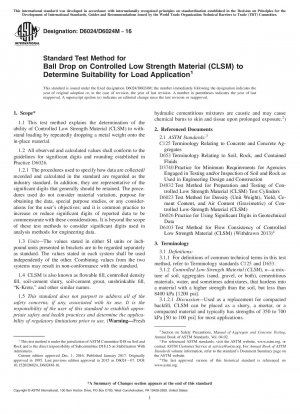ASTM D6024/D6024M-16
Standard Test Method for Ball Drop on Controlled Low Strength Material (CLSM) to Determine Suitability for Load Application
- Standard No.
- ASTM D6024/D6024M-16
- Release Date
- 2016
- Published By
- American Society for Testing and Materials (ASTM)
- Latest
- ASTM D6024/D6024M-16
- Scope
- 1.1 This test method explains the determination of the ability of Controlled Low Strength Material (CLSM) to withstand loading by repeatedly dropping a metal weight onto the in-place material. 1.2 All observed and calculated values shall conform to the guidelines for significant digits and rounding established in Practice D6026. 1.2.1 The procedures used to specify how data are collected/ recorded and calculated in the standard are regarded as the industry standard. In addition, they are representative of the significant digits that generally should be retained. The procedures used do not consider material variation, purpose for obtaining the data, special purpose studies, or any considerations for the user’s objectives; and it is common practice to increase or reduce significant digits of reported data to be commensurate with these considerations. It is beyond the scope of these test methods to consider significant digits used in analysis methods for engineering data. 1.3 Units—The values stated in either SI units or inchpound units presented in brackets are to be regarded separately as standard. The values stated in each system shall be used independently of the other. Combining values from the two systems may result in non-conformance with the standard. 1.4 CLSM is also known as flowable fill, controlled density fill, soil-cement slurry, soil-cement grout, unshrinkable fill, “K-Krete,” and other similar names. 1.5 This standard does not purport to address all of the safety concerns, if any, associated with its use. It is the responsibility of the user of this standard to establish appropriate safety and health practices and determine the applicability of regulatory limitations prior to use. (Warning—Fresh hydraulic cementitious mixtures are caustic and may cause chemical burns to skin and tissue upon prolonged exposure.2 )
ASTM D6024/D6024M-16 Referenced Document
- ASTM C125 Standard Terminology Relating to Concrete and Concrete Aggregates*, 2021-10-01 Update
- ASTM D3740 Standard Practice for Minimum Requirements for Agencies Engaged in the Testing and/or Inspection of Soil and Rock as Used in Engineering Design and Construction
- ASTM D4832 Standard Test Method for Preparation and Testing of Controlled Low Strength Material (CLSM) Test Cylinders
- ASTM D6023 Standard Test Method for Unit Weight, Yield, Cement Content, and Air Content (Gravimetric) of Controlled Low Strength Material (CLSM)
- ASTM D6026 Standard Practice for Using Significant Digits in Geotechnical Data
- ASTM D6103 Standard Test Method for Flow Consistency of Controlled Low Strength Material (CLSM)
- ASTM D653 Standard Terminology Relating to Soil, Rock, and Contained Fluids
ASTM D6024/D6024M-16 history
- 2016 ASTM D6024/D6024M-16 Standard Test Method for Ball Drop on Controlled Low Strength Material (CLSM) to Determine Suitability for Load Application
- 2015 ASTM D6024/D6024M-15 Standard Test Method for Ball Drop on Controlled Low Strength Material (CLSM) to Determine Suitability for Load Application
- 2007 ASTM D6024-07 Standard Test Method for Ball Drop on Controlled Low Strength Material (CLSM) to Determine Suitability for Load Application
- 2002 ASTM D6024-02 Standard Test Method for Ball Drop on Controlled Low Strength Material (CLSM) to Determine Suitability for Load Application
- 1996 ASTM D6024-96 Standard Test Method for Ball Drop on Controlled Low Strength Material (CLSM) to Determine Suitability for Load Application
